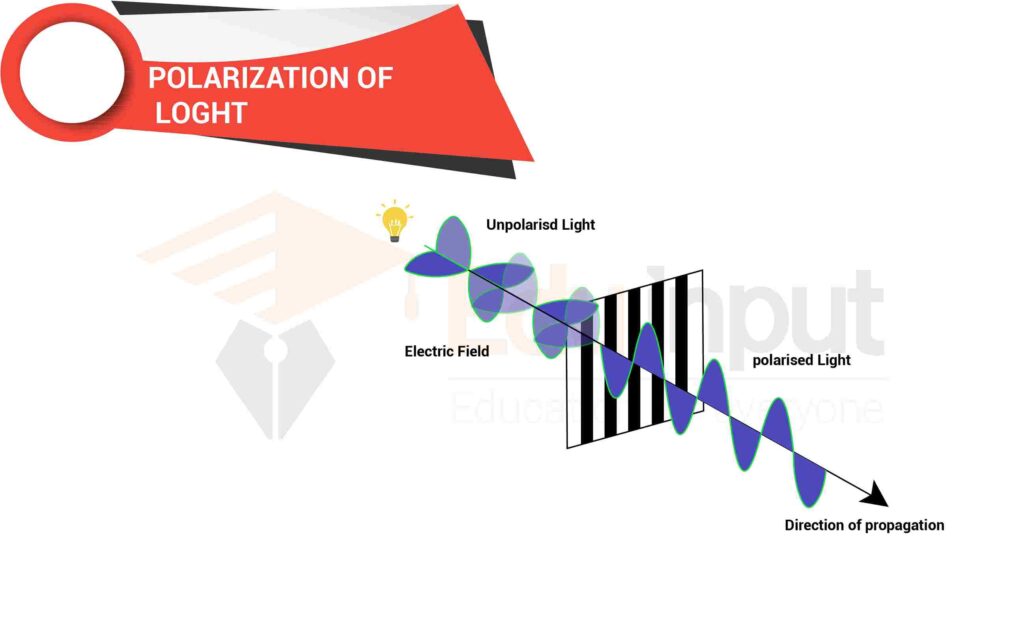Polarization of Light | Production & Detection of Plane Polarized Light
Polarization of light consists of Individual photons whose electric field vectors are all aligned in the same direction. If the light has components of vibration confined only in one plane, then the light is said to be polarized and this phenomenon is called Polarization.
Polarization of Light
The polarization is the property of certain electromagnetic waves in which the direction and magnitude of the vibrating electric field are related in a specified way.
A light wave consists of oscillating electric and magnetic field vectors at right angles to each other. Ordinary light has components of vibration in all possible planes. Such light is unpolarized. If the vibrations are confined only in one plane, the light is said to be polarized.
The transverse mechanical waves in a stretched string can be oriented in vertical, horizontal, or any other direction. In all such cases, the transverse mechanical wave is polarized.
Plane of Polarization
The plane of polarization is the plane containing the direction of vibration of the particles of the medium and the direction of propagation of the wave.
Production & Detection of Plane Polarized Light
An ordinary incandescent light emits un-polarized light like the Sun. This unpolarized light can be polarized by removing all waves from the beam except those having vibrations in one particular direction.
This can be done by:
- Selective absorption
- Scattering by small particles
- Reflection from different surfaces
- Refraction through crystals
Selective Absorption
Selective absorption is achieved by specific types of materials called Dichroic substances.
These are the materials that transmit only those waves, whose vibrations are parallel to a particular direction and will absorb those waves whose vibrations are in other directions. For example Polaroid.
Experiment for selective absorption
Suppose an un-polarized light is made incident on a sheet of Polaroid, the transmitted light will be plane polarized. Now the second sheet of Polaroid is placed in such a way that the axes of the Polaroid, shown by straight lines drawn on them, are parallel.

Light is again transmitted through the 2nd Polaroid. if the 2nd Polaroid is slowly rotated about the beam of light, as the axis of rotation, the light emerging out of the 2nd Polaroid gets dimmer and dimmer and disappears when the axes become mutually perpendicular.
The light reappears on further rotation and becomes brightest when the axes are again parallel to each other. The 1st Polaroid is called Polarizer and the 2nd Polaroid is called the Analyzer.
The polarizer produces plane-polarized light by bringing the vibrations to one plane while the analyzer is used to check whether the emerging beam is plane polarized or not.
This experiment shows that light waves are transverse waves. If the light waves were longitudinal, they would never disappear even if the two Polaroid were mutually perpendicular.
Reflection from Different Surfaces
The reflection of waves of light from water, glass, snow, and rough road surfaces is partially polarized. By using Polaroid sunglasses, the glare can considerably be reduced.
Scattering by Particles
Sunlight also becomes partially polarized because of scattering by the Earth’s atmosphere air molecules.
Refraction through Crystals
Light can be made partially polarized by refraction through crystals. One such important phenomenon is Optical Rotation.
Optical Rotation
When a plane polarized is passed through certain crystals, they rotate the plane of polarization. Such crystals are termed Optically Active Crystals. This phenomenon is called Optical Rotation.
Example:
Quartz, sodium chlorate crystals, sugar, and tartaric acid are typical examples of optical rotation.
A few millimeter thicknesses of such crystals will rotate the plane of polarization by many degrees. Substances like sugar and tartaric acid show optical rotation when they are in solution. This process can be used to find their concentration in the solutions.







Leave a Reply